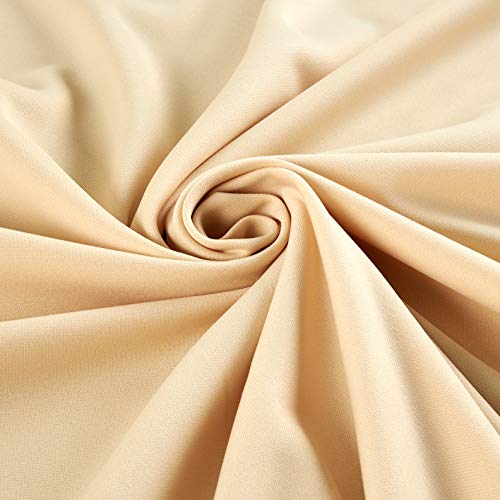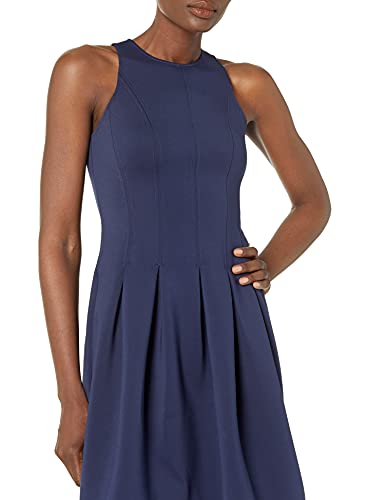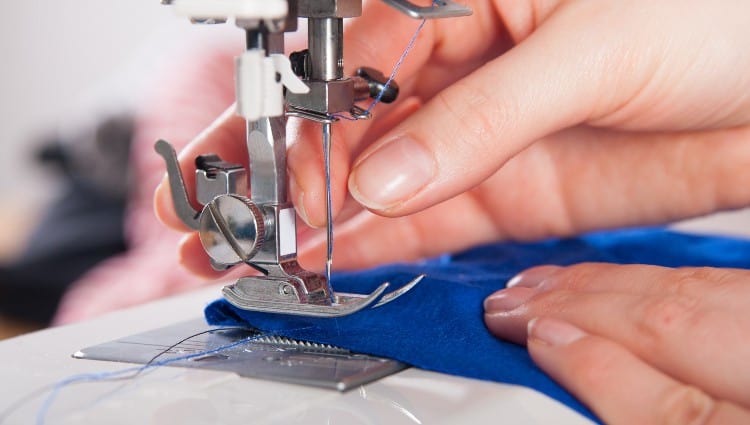What Is Scuba Fabric?
 Scuba fabric is a more fashionable version of neoprene fabric. Both neoprene and scuba are made from the same materials. But neoprene is used for more technical purposes, while scuba is designed to be used for fashionable clothing as well as clothing that needs to be technical but still fashionable- such as dance clothing.
Scuba fabric is a more fashionable version of neoprene fabric. Both neoprene and scuba are made from the same materials. But neoprene is used for more technical purposes, while scuba is designed to be used for fashionable clothing as well as clothing that needs to be technical but still fashionable- such as dance clothing.
You’ve probably actually seen scuba fabric without knowing what you were looking at, especially if you’ve ever shopped for skirts or dresses that are more formal. The fabric is very smooth and heavy, but it has some stretch because it is made from a blend of polyester and spandex/lycra fibers.
Scuba fabric was first produced in the United States by the DuPont Corporation. It is a form of neoprene, which was first used in the 1930s as a synthetic form of rubber. Demand for neoprene increased during World War II due to a shortage of natural rubber.
Over time, neoprene became used for wetsuits for scuba divers because it was waterproof and insulating. This is how scuba fabric got its name. But, neoprene wasn’t ideal for making apparel out of because it wasn’t breathable. This led to the fabric being manufactured to make it more ideal for clothing, so scuba fabric is not technically the same thing as neoprene.
How is Scuba Fabric Made?
 The base material used to make scuba fabric is the same as it is for neoprene. First, base compounds are reacted with a derivative of limestone. This produces a substance known as chloroprene.
The base material used to make scuba fabric is the same as it is for neoprene. First, base compounds are reacted with a derivative of limestone. This produces a substance known as chloroprene.
Next, the chloroprene is turned into a liquid form called polychloroprene by a process called polymerization. The liquid chloroprene is sent to textile manufacturers to be made into a usable form for certain products.
Once at the factory, the liquid chloroprene is combined with certain additives to give it specific characteristics, such as stretchiness. The substance and additives are blended in a mixer, then baked to form the synthetic rubber substance known as neoprene.
The neoprene is sliced into pieces, then sprayed with a coat of epoxy. This is where the difference between the fabric used to make wetsuits vs. scuba fabric comes in. The fabric used to make wetsuits is neoprene covered with nylon fabric. But scuba fabric is neoprene that is covered with a blend of polyester and spandex fabric.
So basically, scuba fabric is a layer of neoprene sandwiched between two sheets of polyester and spandex fabric. The polyester/spandex fabric is a double-knit fabric made with fine thread, giving it a smooth texture. After the fabric is made, it is sold as-is or sent to clothing manufacturers to be turned into apparel.
What Are The Properties of Scuba Fabric?
When learning about or using a certain fabric for the first time one of the first questions you have is what the properties of the fabric are. Knowing the properties is necessary to know what to use the fabric for and what the characteristics of the clothing are going to be. Let’s learn about the properties of scuba fabric in more detail.
Is Scuba Fabric Stretchy?
 Since scuba fabric is made of a small percentage of spandex fibers, it has some stretch. This is one of the more favorable qualities that scuba fabric has and why it is a popular choice for certain kinds of sportswear.
Since scuba fabric is made of a small percentage of spandex fibers, it has some stretch. This is one of the more favorable qualities that scuba fabric has and why it is a popular choice for certain kinds of sportswear.
The amount of stretch that scuba fabric has can also give clothing made from the fabric more body and shape. It’s very popular for some clothing that need to be more form-fitting and have a specific shape to them.
Is Scuba Fabric Breathable?
No fabric is 100% perfect, and scuba fabric isn’t the exception to this. One of the downsides to scuba fabric is that it is not very breathable. This is due to being made from synthetic materials. Neoprene is not known for its breathability, and neither is spandex. Polyester is somewhat breathable, but overall, the fabric has a very low level of breathability.
That said, clothing made of scuba fabric can cause the wearer to feel warm and stuffy. If you’re considering using it for a sewing project, just know that it is not ideal for spring and summer clothing worn when it is warm outside.
Other Properties of Scuba Fabric
Scuba fabric has other ideal characteristics besides being stretchy, but it also has more downsides. Some of the positive characteristics are that scuba fabric has a very smooth texture and it is water-resistant. It is also very flattering and is a suitable fabric for many different body shapes and sizes.
It is also very good at retaining heat. However, that could be either a positive or a negative, depending on how you like your fabrics to feel and in what season you’re wearing the fabric. It also isn’t the most lightweight fabric, but it isn’t a heavy-weight fabric either. These properties mean that it is better to wear scuba fabric in the colder fall and winter months.
Scuba fabric doesn’t have too many other negative characteristics about it. One of the biggest issues that some people have with scuba fabric is that it is made from 100% synthetic materials. It is not an eco-friendly or sustainable fabric if that is important to you.
Lastly, scuba fabric can’t tolerate heat well. The materials used to make the fabric are all various forms of plastic. That means that it can melt easily, so it is important that you are careful when cleaning the fabric.
What is Scuba Fabric Good For?
 If you want to use scuba fabric for a sewing project, you may be wondering what you can use it for. The unique texture and properties that scuba fabric has means that it is ideal for certain types of clothing, but you can’t make just anything out of it.
If you want to use scuba fabric for a sewing project, you may be wondering what you can use it for. The unique texture and properties that scuba fabric has means that it is ideal for certain types of clothing, but you can’t make just anything out of it.
One of the main uses for scuba fabric is in dance clothing. Examples of dancewear include leotards, tights, skirts, and other costumes worn by dancers. It can also be used in certain types of sportswear, such as leggings. But remember that it is not the most breathable fabric, so it isn’t necessarily good to wear when you’re doing a heavy activity.
Another popular use for scuba fabric is in dresses and skirts, but not the type that you would wear casually. Scuba fabric is mostly used to make more formal skirts and dresses, such as those worn to a party or another formal gathering. It’s not a fabric that you would use for clothing that you would wear daily.
How to Sew Scuba Fabric

The thickness and texture of scuba fabric can make it difficult to sew if you’re a beginner or just new to sewing with it. Here are some tips to help you sew scuba fabric.
- As with any fabric, you should pre-wash it by itself first. The fabric shouldn’t shrink, but pre-washing helps to remove any chemicals left on the fabric as a result of manufacturing and prevents the color from potentially bleeding onto your other clothes.
- Scuba fabric is bulkier than other fabrics, but it cuts easily. It’s best to cut it by hand to get the most accurate cut, but be sure to cut slowly so that your cut doesn’t slip.
- You do not have to hem scuba fabric because edges don’t fray. But some people do prefer to hem it so that it looks more finished. It’s up to your personal preference whether or not you decide to hem it.
- Scuba fabric can snag or slip easily during sewing. The best type of needle to use is a stretch or ballpoint needle. Either one will help prevent the stitch from slipping or the fabric from tearing.
- If you’re using a sewing machine, it is recommended to use a walking foot. Since scuba fabric is double-knit, the walking foot will help feed the fabric through the machine more easily.
How to Care For Scuba Fabric
Scuba fabric is not a very high-maintenance fabric. However, there are precautions you should take when caring for it. The biggest issue with caring for scuba fabric is that it can melt if you use temperatures that are too hot.
You can hand-wash scuba fabric or wash it in the washing machine. In either case, use cool or cold water only. Do not use hot water. Due to the fine threads used to make the fabric, it is also recommended to use a mild detergent.
When drying the fabric, do not put it in the dryer. Even the low-heat dryer setting could potentially melt the fabric. Scuba fabric should only be allowed to air-dry. When ironing the fabric, be sure to only use the low-heat setting on the iron.
Popular Products Made from Scuba Fabric
Women’s Skirt
 This women’s skater-style skirt is made from 95% polyester and 5% spandex scuba fabric. It has a comfortable fit and can be worn on a casual or more formal occasion. An elastic waistband and flared silhouette make this skirt flattering for any body type.
This women’s skater-style skirt is made from 95% polyester and 5% spandex scuba fabric. It has a comfortable fit and can be worn on a casual or more formal occasion. An elastic waistband and flared silhouette make this skirt flattering for any body type.
You can choose from over 40 different colors and patterns and 6 different sizes. It is recommended that you hand-wash this skirt, but it is machine-washable as well. Avoid using bleach, and make sure that you hang it up to dry.
Women’s Dress
 This women’s dress is made from a blend of 90% polyester, 5% spandex, and 5% cotton. The dress has a pencil silhouette, but the fabric’s stretchiness makes it fit comfortably instead of tight. The style of the dress is appropriate for both business and formal events. Choose from 28 styles and patterns and 6 sizes. The dress has a zipper closure so, it is easy to put on and take off. The percentage of cotton helps the dress to be slightly more breathable than traditional scuba fabric. It can be machine-washed, but hand-washing is recommended.
This women’s dress is made from a blend of 90% polyester, 5% spandex, and 5% cotton. The dress has a pencil silhouette, but the fabric’s stretchiness makes it fit comfortably instead of tight. The style of the dress is appropriate for both business and formal events. Choose from 28 styles and patterns and 6 sizes. The dress has a zipper closure so, it is easy to put on and take off. The percentage of cotton helps the dress to be slightly more breathable than traditional scuba fabric. It can be machine-washed, but hand-washing is recommended.
Conclusion
If you were unsure what, scuba fabric was, I hope this guide has answered all of your questions. It does share some characteristics with the wetsuits that scuba divers wear, but scuba fabric is designed to be more fashionable. It is an ideal fabric for making flattering dresses and skirts. If you enjoyed this article, share it with others and leave a comment. Thanks for reading!
